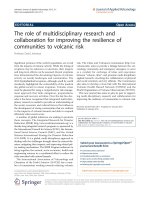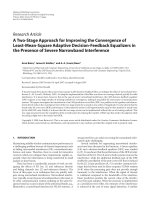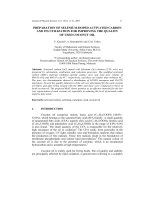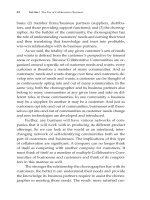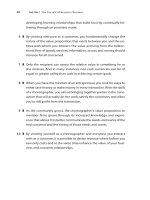Proposed policy solutions for improving the disaster early warning system in Vietnam to increase the efficiency of loss mitigation, prevention
Bạn đang xem bản rút gọn của tài liệu. Xem và tải ngay bản đầy đủ của tài liệu tại đây (246.9 KB, 15 trang )
JSTPM Vol 4, No 2, 2015
51
PROPOSED POLICY SOLUTIONS FOR IMPROVING
THE DISASTER EARLY WARNING SYSTEM IN VIETNAM
TO INCREASE THE EFFICIENCY OF LOSS MITIGATION,
PREVENTION
Dr. Pham Thi ThanhNga
Research Intern of ASEAN-US science and technology programme
Dr. Ta Doan Trinh1
National Institute for Science and Technology Policy and Strategy Studies
Abstract:
The devastation of natural disaster is not only related to the danger level of phenomena
but also depends on the prevention/mitigation capacity of the community. Early warning is
the early recognition on disasters, an essential component of risk reduction, an important
tool to protect lives and minimize material losses that may be caused by disasters. Effective
operation of an early disaster warning system requires all of four interconnected
components in the system, and controlled by mechanism, policies and legislation related to
different management agencies from central to local level. This paper will make in-depth
analysis on the position of the disaster early warning system in the legal document system
relating to disaster management issued from early 1990s until the Law on Disaster
Prevention officially took effect in May, 2014. The four main components of the disaster
early warning systems was reviewed to see clearly the gap between policy and
implementation with a view to making recommendations for improvement of the disaster
early warning system and increased efficiency of the disaster risk management in Vietnam.
Keywords: Disaster Risk Management; Early warning of natural disasters; Prevention and
mitigation of natural disasters.
Code: 15051401
1. Position of the disaster early warning system in the policy document
system on disaster prevention in Vietnam
Vietnam is one of the countries being regularly affected by natural
disasters, 70% of the population faced with dangerous weather phenomena
such as typhoons, heavy rains and floods. Every year, natural disasters
make hundreds of people killed and wounded, material losses of up to VND
thousands of billion. Natural disasters not only make losses in terms of lives
and property, but also caused serious long consequences, such as many
homeless people, production stoppage due to devasting infrastructure,
1
The author’s contact is at
52
Proposed policy solutions for improving the disaster early warning system…
adversely impact on environment, and negative socio-economic
consequences. For example, only the Xangsane 2006 storm made a loss of
nearly USD 1 billion for 15 central provinces. On average, each year,
disasters cause losses equivalent to around 1.5% of GDP.
The devastation of disasters is not only related to the danger level of the
phenomena themselves but also it depends on the human prevention,
mitigation capacity. Early warning is the early recognition on disasters, an
essential component of risk reduction, an important tool to protect lives and
minimize material losses that may be caused by disasters. Therefore, early
warning of natural disasters was especially emphasized in the Ordinance on
Flood and Storm Prevention 1993 (Ordinance No. 09/L-CTN dated 20th
March 1993) and in the following Ordinance 2000 to amend and revise
some articles of the former Ordinance 1993 (Ordinance No. 27/2000 /PLUBTVQH10). However, the provisions outlined in the Ordinance were
simple, not focused on the issue of building a specific system, only
assigning the agency responsible for providing forecasts, warnings relating
to storms, floods and the agency responsible for disseminating such
information to public as stipulated in Decree No 32/CP dated 20th May
1996 and Decision No.581/QD-TTg dated 25th July 1997, particularly, it did
not involve the participation of community in disaster warning. In addition,
various other kinds of natural disaster such as earthquakes, tsunamis,
landslides,... were not mentioned in the legal documents at that time.
In recent years, Vietnam has made much effort to cope with natural
disasters by reducing risks, promoting the improvement of physical and
legal infrastructure for disaster management with the issuance of the
National strategy on disaster prevention and reduction up to 2020 approved
by the Prime Minister in Decision No. 172/2007/QD-TTg and Law No.
33/2013/QH13 on disaster prevention passed by National Assembly on 19th
June 2013 and effective from 01st May2014. The strategy began to
emphasize the development and modernization of the natural disaster early
warning system, but not including legal institutions and legal provisions on
financing for the system from central to local level. Law on Disaster
Prevention prescribed that community has the right to involve in disaster
prevention planning at grass-root level. However, disaster risk reduction in
the context of climate change is still a significant challenge, especially in
respect of developing early warning capacity for all types of disaster as
mentioned in the Law on Prevention so as that community can be capable
of disaster preparedness and response.
The Second World Conference on Disaster Reduction held in January 2005
adopted the "Hyogo Framework for Action 2005-2015" with strategic
approach and synthesis in disaster risk management. The framework
JSTPM Vol 4, No 2, 2015
53
emphasizes the importance of early warning as the main tool to minimize
risk, it encourages the development of early warning systems with focus on
those audiences who could be affected, especially providing timely and
understandable alert to community, including instructions on how to take
action to cope with disasters (UNISDR, 2005a). After 15 years of
implementation of the Hyogo Framework for Action, 3rd World Conference
on Disaster Reduction held in March 2015 at Sendai summarized and gave
new Framework for Action with four priorities, including: (i) knowledge on
disaster risks; (ii) risk management enhancement; (iii) investments to
disaster risk reduction; (iv) strengthening disaster preparedness capacity for
effective response. To see clearly the priority issues to focus on in the
action framework 2015-2030 Sendai, please refer to Section 2 below where
it analyzes the principle of an early warning system for disaster prevention.
2. Principles of a disaster early warning system
Disaster Early Warning System is a combination of tools and processes for
the implementation of legal framework by the state management, not
merely for forecasts and warnings. Recently, the United Nations Office for
Disaster Risk Reduction (UNISDR) had emphasized an effective early
warning system should include four key components, i.e: (i) knowledge on
disaster risks; (ii) risk management enhancement; (iii) investments to
disaster risk reduction; (iv) strengthening capacity in disaster preparedness
for effective response. In this system, the four components are not only
linked together in a logical sequence, but also have direct two-way
relationship and interactive with each other to ensure comprehensive
capacity of the system, from understanding of disasters to the preparation
and response capacity. Missing one of the four components mentioned
above can lead to failure of the whole system. The warning issue is of
national responsibility, so roles and responsibilities of the parties involved
should be clearly defined by regulations applicable in the country from
local to national level.
Source: ISDR-PPEW 2005a, UN 2006
Figure 1. Four main components of a disaster early warning system
54
Proposed policy solutions for improving the disaster early warning system…
2.1. Understanding of the risks
Risk stems from a combination of natural disasters and vulnerability in
specific regions. Risk assessment requires the collection and analysis about
system of data inconsideration of fluctuation nature of natural disasters as
well as vulnerability of the affected place due to human made activities
such as urbanization, the volatility of agricultural land use, environmental
destruction and climate change. The risk assessment and risk mapping
should give priority to early warning systems and instructions for
preparation to mitigate potential losses caused.
2.2. Monitoring and warning
Warning is the central part of the system and should be built on a solid
scientific foundation to produce disaster forecasts, warnings on coming
storm, rain, flooding with high accuracy, in a timely and continuous
manner. Continuous supervision and monitoring on relevant parameters is a
critical element for accurate warnings at appropriate time. On this basis, it
can make right decision about preparedness such as evacuation, relocation
and protection of people, property, works to limit losses/damages that might
occur.
Although it is the most important factor, it is only a component that
constitutes the system. This was an old idea of an early warning system as
reality shows that even a forecasting system with technically high quality it
is still insufficient to achieve the mitigation of losses/damages as expected.
The human factor in early warning systems is the most important (Basher,
2006). The failure of the system often occur in “Communication” and
“Preparedness to respond” factors. Taking as an example, the 13 degree
typhoon Xangsane in 2006, in Central provinces made 180,000 people
affected, thanks to proper responses the loss from this storm was
minimized, only 72 deaths compared to 110 people died in Philippines
(CCFSC).
2.3. Dissemination of warnings and the communication issue
Warning needs quick delivery of information to those at risk of direct and
indirect impacts of disaster. Warning Newsletter should contain clear, brief
but useful information for timely preparation of responses to help
effectively protect people and property. Communication system among the
central, provincial and community needs to be ready. The use of multiple
communication channels (such as telephone, fax, internet, television, radio,
loudspeakers and especially modern means of communication such as
satellite) is indispensable to ensure maximum effectiveness of timely
JSTPM Vol 4, No 2, 2015
55
warning to the concerned authorities and people, as well as to prevent the
incidence occurred to any of the information channels.
2.4. Responsive capacity
Important requirements to improve disaster prevention is that community
must understand about the risks, timely access to warnings, and early
implement responses. Plans for prevention and response to disasters must
be developed, tested and regularly practiced, in which, training in relevant
methods should be provided for community to ensure safety of people and
property, refuge them when disasters occur at different levels.
Natural disaster early warning system includes four components to be
developed, strengthened and effectively implemented, firstly, it should have
a legal basis and implementation plans and policies for disaster risk
management from national to local level. According to the national report
on the implementation of Hyogo Framework for Action, significant
progress was made over the period 2005-2009 in legislation enhancement
for disaster risk management to address the shortcoming in disaster
preparation and response (Llosa, S., Zodrow, I. 2011). By 2011, 48
countries, out of which nearly half of them were low- or lower middleincome countries, had reported significant achievements in the development
of national policies and legislation for disaster risk management and
implementation of the Hyogo Framework for Action.
Based on the principles of an early warning system with specific
requirements for each component in the system as recommended at the 3rd
International Conference on Early Warning in Germany in 2006 (UNEP,
2012), we will go into detailed in Section 3 of analysis of each component
of the disaster early warning system of Vietnam with the aim of making
concrete recommendations for improved performance of the system.
3. Current status of the Vietnam natural disasters early warning
system compared to the requirements set out in policy documents
Vietnam is also one of the countries in the region that issued early strategies
for disaster management since 1990 with the establishment of the Central
Committee for Flood and Storm Control (CCFSC). The national action
strategy on prevention and mitigation of natural disasters up to 2020 was
approved by the Government in November 2007, with the main objective to
integrate disaster risk management into socio-economic development plans.
Traditionally, Vietnam used to focus on preparedness to respond to natural
disasters by various measures such as construction and upgrade dyke and
embankment system. Disaster risk reduction activities were mentioned in
56
Proposed policy solutions for improving the disaster early warning system…
the strategy, but the focus was placed more on responding measures by
incorporating construction and non-construction works. New strategic
approach to deal with disaster risk reduction now is not only responding but
also improving prevention measures to reduce losses caused by natural
disasters, while mitigating the natural disaster risks involved. The concept
of disaster risk mitigation is a comprehensive approach to respond to
natural disasters and has become the guiding principle for international join
action to prevent disasters.
More recently, with the adoption by National Assembly on the Law on
natural disasters prevention, the Government issued Decree No.
66/2014/ND-CP on 04th July 2014 to provide detailed guidelines for the
implementation of some articles of the Law, Prime Minister issued
Decision No 44/2014/QD-TTg of 15th August 2014 concerning detailed
provisions on disaster risk levels, Decision No 46/2014/QD-TTg of 15th
August 2014 regarding regulations on disaster forecasting, warning and
communication. These documents has really improved the legal framework
for disaster management in Vietnam. The principles of a disaster early
warning system has been guaranteed by the country institutional, legal
documents. At the national level, the first two of four components of the
disaster early warning systems (knowledge about disaster risks,
strengthening risk management) are under the responsibility of Ministry of
Natural Resources and Environment and Academy of Science and
Technology of Vietnam; the third component (investment for disaster risk
mitigation) under the responsibility of various communication agencies
(Voice of Vietnam, Vietnam Television, Ministry of Information and
Communications); the fourth component (strengthening disaster
preparedness for effective response) under the responsibility of the Central
Steering Committee on natural disasters prevention (formerly called Central
Committee for Flood and Storm Prevention) and the National Committee
for victims search and rescue. These four components are vertically
connected from top central down to grass-root level to ensure that in
provinces there exist an unit responsible for disaster warning,
communication, and steering of responses.
To analyze the performance of the disaster early warning system in
Vietnam from central to local levels, a group of authors had studied the
report on disaster management of local and foreign organizations, along
with actual survey on disaster agencies at some central provinces frequently
prone to natural disasters such as Da Nang, Quang Nam, Quang Ngai,
where it shows the situation relating to the four basic components of the
system compared to the following set out requirements:
JSTPM Vol 4, No 2, 2015
57
3.1. For understanding of the risks
The basic issue was it should have:
- Cooperation of relevant agencies to implement disaster risk and
vulnerability assessment;
- Community involvement in defining characteristics of the natural
disaster, historical data based disaster mapping;
- Analysis of vulnerability of communities to all kinds of natural disasters
should take into account factors of gender, disability, economic
diversity, environment;
- Integration of risk assessment into risk management plans and warning
information, as well as easy access to risk database.
In the national progress report on the implementation by Viet Nam of the
Hyogo Framework for Action in the period 2009-2011 (MARD, 2010),
concerning “Priorities for Action 2: Identify, assess, monitor disaster risks
and enhance early warning”, it admitted that Vietnam had not yet conducted
any risk assessment in a systematic way for many types of disaster, there
was neither a national database on disaster risk maps, furthermore, the data
were relatively scattered in different management units after project
implementation.
It could be seen that it was the weakest point in the system from the central
to local levels. The agencies are responsible for disaster warning were
hydrometeorology agencies, the steering committee of flood and storm
prevention, but they had no maps of disaster risk and vulnerability level of
national and local level, or if they did, these documents were too old. The
establishment of such maps at the local and national levels requires big
resources and the participation of experts from various fields. Moreover, the
Decision No 44/2014/QD-TTg of Prime Minister promulgated on 15th
August 2014 providing details on disaster risk level just focused on
decentralized risks corresponding to the intensity of calamity, not taking
into account the level of vulnerability of community and environment.
Therefore, the implementation of other components of the system was not
synchronized, confusing when planning and the integrating disaster risk
into socio-economic development plans.
3.2. As for disaster monitoring and warning
The central component of the system requires:
- Mechanisms and institutions for the system operation with clear roles
and responsibilities of the warning issued agencies;
58
Proposed policy solutions for improving the disaster early warning system…
- Continuous monitoring system set up to ensure the data is acquired,
processed in real-time and for long-term storage;
- Disaster forecasting and warning system can provide warnings based on
the data collected by scientific and appropriate methods, simultaneously
warning information is to be transmitted in a fast and most efficient
manner at the requirement of users.
The hydrometeorology observation network is one of the oldest database
with continuous development, in particular, investment by Government in
recent years was increased. By 2012, the measuring network had 1,300
stations, including 233 hydrological, 185 meteorological, and 19
oceanographic stations, respectively, out of them 155 stations for air and
water measurement, more than 700 rain gauge stations, 6 air surveillance
stations, 8 high wind measuring stations, 7 radar observation stations (WB,
2010). With the increase in the number of stations, the volume and quality
of hydro-meteorological information was significantly enhanced, served
effectively for the supervision and providing warnings of rain, storm, flood
in a timely manner, with the forecast time of hurricane up to 72 hours.
However, compared with other advanced countries like Japan, where it has
a network of 1,300 automatic meteorological stations with an average
density of 17 km2/station, the average density in Vietnam is low, about 120
km2/station; Moreover, the station density of our country is unevenly
distributed, some station located at 1,000 km apart. This was one of the
biggest difficulties for a disaster early warning system to operate
effectively, because if input information were incomplete, it would be
difficult to get accurate forecasts, even owning the most advanced
equipment and method. The use of remote sensing data to substitute sparse
measuring stations as a solution to improve the quality of alert, however,
there were still many restrictions on the source of data, the ability to exploit
it, especially at the local level.
In addition, there were restrictions on data sharing within and outside the
network. It also led to challenges for the operation of other components in
the system, especially for historic data on disasters to build the risk map, to
raise awareness about the risks and take active responses to disasters.
3.3. Concerning warnings and communications to public: it needs to
ensure: (i) an organized decision-making process be institutionalized with
full authority and responsibility; (ii) systems and equipment for effective
communication to whole community by all form, in two-way, with
preventive measures; (iii) the warning information understandable and
realizable.
JSTPM Vol 4, No 2, 2015
59
Law on Natural Disasters Prevention in 2013 and the Prime Minister
Decision No. 46/2014/QD-TTg dated 15th August 2014 issuing regulations
on disaster forecasting, warning and transmission has ensured this third
components of system completely institutionalized, with the mobilization of
the communication network of TV, radio, newspapers, telecommunications,
military safe guard agencies, and other internal units. In addition to general
warning information on the phenomenon, direct specific information on
preparedness to respond also been transmitted to community. This was a
major effort in the system being implemented for years to cope with
disaster. Especially, in the village, loudspeakers have long been very
effective in conveying information in response to storms, floods. However,
the mode of transmission still needs to be more diversified with new
technology updates such as satellite communications in order to ensure
uninterrupted communication during natural disasters. The warning by
SMS has recently been applied, but no specific mechanism issued for the
event of disasters, so localities thought that was costly to send out
information to multiple objects. In particular, the information was just one
way dimension (Figure 2), from forecasting agencies to community, not
vice versa way on the development of natural disasters, in order to help the
issuing and steering agencies know better about the actual facts happened
for timely update of changes in forecasts and response steering. This was a
necessary direction for the system to get the ability to minimize losses.
Central Center for
Hydrometeorologica
lPrediction
Institute of
Geophysics (VAST)
Forecast
Central Steering Committee on natural
disasters prevention (CCFSC)
Central Search and
Rescue Commission
(VINASACOM)
Information alert and response
Standing OfficeCCFSC
and VINASACOM
Regional Center for
Hydro-meteorological
Prediction
Flood prevention
committee at ministerial
level
Provincial/district/commune Command
Unit of flood prevention, search and rescue
Source: CCFSC website
Figure 2. Process of disaster warning management
Moreover, it should be focused on the improvement of the “timeliness” of
the alerts and the forecast time limit. Currently, the process of collecting
and processing data for making the warning messages take about 3-4 hours,
60
Proposed policy solutions for improving the disaster early warning system…
on an average, before transferring to the central disaster management
agency, then the steering information for response takes about 0.5 - 1 hour
before it can be disseminated to subordinate units. Thus, it may take 3 hours
from issuing a warning message to the people effected by the disaster. A
study on the benefits of early warning of Schroeter & nnk (2008) showed a
correlation between the preparation time and the damage caused by flash
flood as follows: predicting time before 12 hours shall likely reduce up to
60% of damages, while with predicting time before 1 hour it was only 20%
damage reduction.
3.4. For response capacity: (i) Responsible competent authority should
have trust on the warning; (ii) There should be plans to prepare and respond
to each type of disaster, in which the mapping of disaster risk and
vulnerability levels should be used for planning; (iii) Capability of response
of communities must be evaluated and strengthened; (iv) Community
awareness and education must be regularly enhanced on all matters
including disaster risks, the contents of disaster warning, reliability, damage
prevention and mitigation measures.
The assessment on the National progress report on implementation of the
Hyogo Framework for Vietnam Action during 2009-2011 (MARD, 2010)
said that the level of achievement was low (index 2 on the scale of 5) in
respect of community response capacity improvement, it was due to limited
ability in risk management at all levels, especially the low autonomy of
community. In recent years, building capacity to cope with natural disasters
is one of the priorities of ODA projects and programs and interventions of
non-governmental organizations for Vietnam focusing on communities at
district, commune level. But in general, the results of these programs and
projects implementation were only in the area of raising awareness on
calamity hazards and regulations compliance.
As mentioned above, the gap in the first component “risk perception” of the
system lead to inadequacies in the three other components. Through
surveys, disaster preparedness plans at local level was largely dependent on
the knowledge and experience of the authorities concerned. Historical data
of local were not scientifically stored, evaluated to serve disaster
prevention. A significant limitation was local staff worked only part-time
for disaster prevention, even without a national training programme for
them on technology and management skills in mitigation of damages.
JSTPM Vol 4, No 2, 2015
61
4. Some policy recommendations to improve the disaster early warning
system in Vietnam
Through actual analysis, the process of natural disasters early warning in
Vietnam is at present not yet complete in all sectors, in particular, the
linkage between the four components need to be strengthened not only on
technical aspect, which is important, but also management aspect to create
systems of multi-sectorial, multi-disaster, multi-stage response character,
comprehensive so as to enhance community education, increase awareness
on disaster risk, conduct effective warning transmission to community for
them to ensure preparedness to respond. Such a system will ensure
economic efficiency as well as proactive responses to natural disasters
which are becoming more and more brutal, unusual in the context of the
current climate change. Pattern of a successful early warning system as
above was mentioned in the recent global assessment report on disaster
reduction (Rogers and Tsirkunov, 2011), it was a multiple disaster early
warning system of Shanghai developed by the Chinese meteorological
agency in conjunction with the Shanghai Government with the support of
the World Meteorological Organization.
The disaster early warning system of Shanghai is fully in compliance with
the principle of four basic components, but different in terms of form, the
system consists of two technical and management aspects as shown in
Figure 3. Thus, technically speaking, outside the system is the platform of
monitoring and detection, forecasting and information dissemination
system, the need for multiple disaster database, especially the support
system for decision making for responding work with multi-agency link
network, so the data can be easily shared, information can be consulted
before providing warnings for people. The management aspect of the
system ensures shorter preparation time for an earlier response.
Monitoring and detection system of multiple disasters
System for forecasts and warnings
Technical Systems
Decision-making support system
Warning informationdissemination system
Multi-Disaster early warning
systems
Database of multiple disasters information
Multi-link agency network
Multi-sector coordination mechanism
Management system
The system for community safeguard
Intercity/regionprevention mechanisms
Source: Rogers & Tsirkunov, 2011
Figure 3. Model of a multiple disaster early warning system
Proposed policy solutions for improving the disaster early warning system…
62
Clearly, for a disaster early warning system to be effective it needs to
realize a series of regulations in respect of cross-sectorial coordination,
monitoring and alerting, risk analysis, planning for emergencies and
preparing response measures. Through analysis of the current situation of
the disaster warning system in Vietnam, in comparison with the other
effective system as assessed by international community, and in reference
to the latest recommendations of UNISDR, the study team launched some
policy recommendations for better management of the natural disasters
early warning system in Vietnam, as follows:
- Natural disaster early warning system of Vietnam needs to have a shift
towards a multi-disaster system with multi-sector involvement in the
development and operation of the system from the central to local levels;
- It should change the approach of assessing disaster risk and impact on
communities so it can strengthen the involvement of community in all
stages of disaster management including preparation, prevention,
response and recovery.
In order to develop a multi-disaster system with approach of community
based assessment of disaster risk and impact, management policies should
promote both aspects: technical platform and operational mechanism,
specifically:
a) As for technical platform
- Mobilize all necessary financial and professional resources to build a
national database on disaster information; Conduct risk assessment and
establish extended disaster, vulnerable maps, to multi-natural disasters
by remote sensing and GIS technologies and, including storms, floods,
heavy rains, landslides, drought, rising water,…; Regularly update of
other risk factors and their impacts;
- Improving the quality of information of forecast and warning systems:
Improved surveillance and detection by strengthening and improving
the network of disaster observation stations: To step up to automation
technology and increase the density of ground monitoring networks,
diversify sources of data, especially remote sensing data;
Developing mechanisms to promote the use of geospatial data in
disaster management;
Strengthening specialized information systems: Enhanced speed for
data collection from local to central level and vice versa;
JSTPM Vol 4, No 2, 2015
63
Improving equipment of the forecasting system: Upgrade and
improve forecasting models appropriate for regional conditions,
strengthening input data, especially remote sensing data, developing
forecasts combined with statistical models;
Improved content of alerts for different objects, e.g: agencies relating
to production and business, newspapers, radios, various sectors such
as agriculture, transport, health, and community;
Integrating disaster risk and impact information on the warning
message.
- System of dissemination warning information:
Maximum mobilization of all means of communication and
dissemination of information, to ensure that information reach all
subjects at risk of to be affected;
Setting up feedback information channels from the field of disaster to
any level of agencies concerned: Update disaster information before,
during and after the incident.
- In respect of decision-making support system:
To develop tools to support decision-making of concerned authorities
to direct disaster prevention: Integration of historical information,
statistic data on disasters, such as frequency, maximum, minimum
effects…;
To develop information-sharing mechanism between technical and
management agencies.
b) With regard to mechanism of operation:
- Multi-sectorial coordination mechanism: implementation of all
components of the system, with the exchange of feedback among the
parties involved, namely, Hydrometeorology agencies need to know
about the process of decision-making of steering bodies to provide
warnings more consistent with management requirements; feedback
quality warnings, forecasts for users;
- The system should work to ensure community benefits: the design and
operation of disaster early warning systems needs to be based on
commitments of cooperation and exchange of information for the benefit
of the community; develop plans of preparedness to protect community
taking into account vulnerable subjects such as the elderly, disabled
persons, young children;
64
Proposed policy solutions for improving the disaster early warning system…
- Inter-city/inter-region prevention mechanism: ensuring the coordination
to mobilize resources to respond to disasters around the affected area./.
REFERENCES
Vietnamese:
1.
Law on Natural Disasters Prevention, number 33/2013/QH13 by the National
Assembly ratified on 19th June 2013.
2.
Decision No 172/2007/QD-TTg dated 16th November 2007 of Prime Minister
approving the “National Strategy for natural disasters prevention and mitigation up to
2020”.
3.
Decision No 44/2014/QD-TTg dated 15th August 2014 of Prime Minister giving
detailed provisions on disaster risk levels.
4.
Decision No 46/2014/QD-TTg dated 15th August 2014 of Prime Minister providing
issues relating to disaster forecasting, warning and communications.
5.
MARD - Ministry of Agriculture and Rural Development. (2010) Vietnam National
progress report on the implementation of the Hyogo Framework for Action (20092011) - interim. />
English:
6.
ADPC. (2003) Disaster management in Southeast Asia, an overview. Compiled and
written by Ms. Lolita Bildan, Information Manager, PDR-SEA1.
7.
UNISDR - United Nations International Strategy for Disaster Reduction. (2005)
Hyogo Framework for Action 2005-2015: Building the Resilience of Nations and
Communities to Disasters. />
8.
United Nations. (2006) United Nations, Global Survey of Early Warning Systems - An
assessment of capacities, gaps and opportunities toward building a comprehensive
global early warning system for all natural hazards. A report prepared at the request
of the Secretary-General of the United Nations.
/>
9.
WB. (2010) Weathering the Storm: Options for Disaster Risk Financing in Vietnam.
10. WMO - World Meteorological Organization. (2010) Guidelines on Early Warning
Systems and Application of Now casting and Warning Operations. PWS-21,
WMO/TD No. 1559, 22pp.
/>11. UNEP. (2012) Early Warning Systems: A State of the Art Analysis and Future
Directions. Division of Early Warning and Assessment (DEWA), United Nations
Environment Programme (UNEP), Nairobi.
/>12. Basher R. (2006) Global early warning systems for natural hazards: systematic and
people-centred. Phil. Trans. R. Soc., 364, pp. 2167-2182
JSTPM Vol 4, No 2, 2015
65
13. Schroeter, K. and nnk. (2008) Effectiveness and Efficiency of Early Warning Systems
for Flash-Floods (EWASE). First CRUE ERA-Net Common Call - Effectiveness and
Efficiency of Non-structural Flood Risk Management Measures, 132pp.
14. Llosa, S., Zodrow, I. (2011) Disaster risk reduction legislation as a basis for effective
adaptation - (UNISDR): Revealing Risk. Redefining Development.
15. Rogers, D., Tsirkunov, V. (2011) Implementing Hazard Early Warning System.
Global Facility for Disaster Reduction and Recovery (GFDRR). 48pp.

